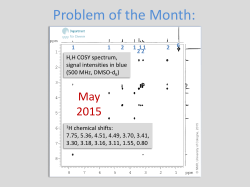
Solutions - Chemistry at Caltech
Chemistry 143 Problem Set 1 Solutions April 10, 2015 Problem 1 The structures 1b and 2b are optically active (chiral) porphyrin derivatives for use in enantioselective epoxidation. The threitol-strapped groups are chiral - one can verify that they all have the same (S,S)- stereochemistry. Therefore, they each have a C 2 rotational axis of symmetry. (If either had a mirror plane of symmetry, then it would not be chiral). In 1b, the C2 axis of symmetry makes Ha equivalent with its neighbor on the same double bond linkage. In 2b, the C 2 axis of C2 axis symmetry makes one double bond linkage equivalent to the other on the Hb other side of the porphyrin ring. Hb Therefore, in 1b, we expect the chemically equivalent protons Ha to be Ha Ha Hb Ha observed as a singlet (Spectrum B). C2 axis But in 2b, we expect to see H a and H b Hb inequivalent and coupling to each Ha other (Spectrum A). JACS 1995, 117, 692. Problem 2 (CH3)4Sn (150 MHz, CDCl3) Outer Lines: -1237.23-(-1573.36) = 336.1 Hz Inner Lines: -1244.60-(-1565.99) = 321.4 Hz (µ119Sn/µ117Sn) = (-1.0409/-0.9949) = 1.046 = (336.1/321.4) 115Sn peak is just a tiny blip (maybe next year I'll get a better spectrum). (µ119Sn/µ115Sn)* 336.1 = (-1.0409/-0.9132)*336.1 = 294.9 Hz ALL I=0 Sn isotopes: 8.58% 119Sn(CH3)4 7.61% 117Sn(CH3)4 0.35% 115Sn(CH3)4 ? Problem 3 b 2.02 dd, 2H, J = 6.7, 8.5 Hz c 1.62 dt, 1H, J = 5.1, 6.7 Hz d 1.20 dt, 1H, J = 5.1, 8.5 Hz 1J(119Sn-C) ~ 336.1 Hz 1J(117Sn-C) CO2Me CO2Me Hd Hc ~ 321.4 Hz Hb Hb CO2Me CO2Me A2MX Pople Notations: A4 The cis-diester is the only structure that we would expect to give three resonances. Hx Hx' Ha CO2Me Ha' CO2Me AA'XX' Problem 4 Unknown Cyano Compound C10H8NO2Cl IR shows 2253.7 cm-1 (CN group) and 1732 cm-1 (C=O group). 1H NMR (500 MHz) and 13C (60.9 MHz). Step 1: Unsaturation # = (2*C-H+N-Cl+2)/2 = (20-8+1-1+2)/2 = 7 Step 2: In addition to C=O (165ppm) and CN (117.9 ppm), six sp2 carbons indicate aryl ring.1+2+4=7 Step 3: No Symmetry in 13C NMR (10 lines = 10 C) a 7.90 ddd, 1H, J = 0.5, 2.0, 8.0 Hz Step 4: 1H Spin system: 8.0 Hz H 6.0 Hz b 7.59 ddd, 1H, J = 2.0, 7.0, 8.0 Hz C O O 2 Ha C H2 CN Cl Hd 7.0 Hz Hb 8.0 Hz Hc c 7.56 ddd, 1H, J = 0.5, 2.0, 8.0 Hz d 7.47 ddd, 1H, J = 2.0, 7.0, 8.0 Hz e 4.57 t, 2H, J = 6.0 Hz f 3.04 t, 2H, J = 6.0 Hz Step 5: Connect the -Cl, -CN and -COO- groups to the spin system with consideration of chemical shifts: The Aryl group is not directly attached to oxygen or the ipso-carbon would be 150-160 ppm. 4.57 ppm - CH2 attached to oxygen (60 ppm 13C shift). 3.04 ppm - attached to Cyano, (17 ppm 13C shift), not chloro (more downfield in 1H and 13C NMR). Problem 5 (a) The vicinal coupling constants (3JHH) of a cyclopentadienyl ring are all nearly zero. Reaction of 1 with NaBH 4 produces the alcohol 2 which bears a chiral center at the new -CH(OH)Me carbon. This renders the four cyclopentadienyl protons diastereotopic (although only one pair is resolved in the 1H NMR. But in the 13C NMR, all five carbons of the top Cp ring are inequivalent. diastereotopic (inequivalent) H OH diastereotopic (inequivalent) C Fe CH3 2 Problem 6 The main peak (singlet) is from the 3J 194Pt-194Pt isotopic species. The other peaks are from the 195Pt-194Pt species. 1J 2J S When one Pt nucleus is 195Pt, each 31P nucleus couples with different J value. Ph3P 195Pt 194Pt PPh3 The 195Pt nucleus will maintain the same spin quantum state during the CO CO acquisition of the 31P scan. So we have a superposition of the spectra (two (each 31P nucleus couples to 195Pt) overlapping AB patterns) for: (I = +1/2) (I = -1/2) S (I = 0) S (I = 0) It appears from the leaning of the AB patterns that the peaks picked in red go together and likewise the peaks picked in green also go together. That would indicate that the J values 1JPt-P and 2J Pt-P are the same sign. From the reference: 1J Pt-P = 3161 Hz 2J Pt-P = 122 Hz 3J P-P = 149 Hz Ph3P 195Pt CO 194Pt PPh3 CO Ph3P 195Pt CO 1J Pt-P 2J Pt-P 3J P-P 194Pt CO PPh3
© Copyright 2025















